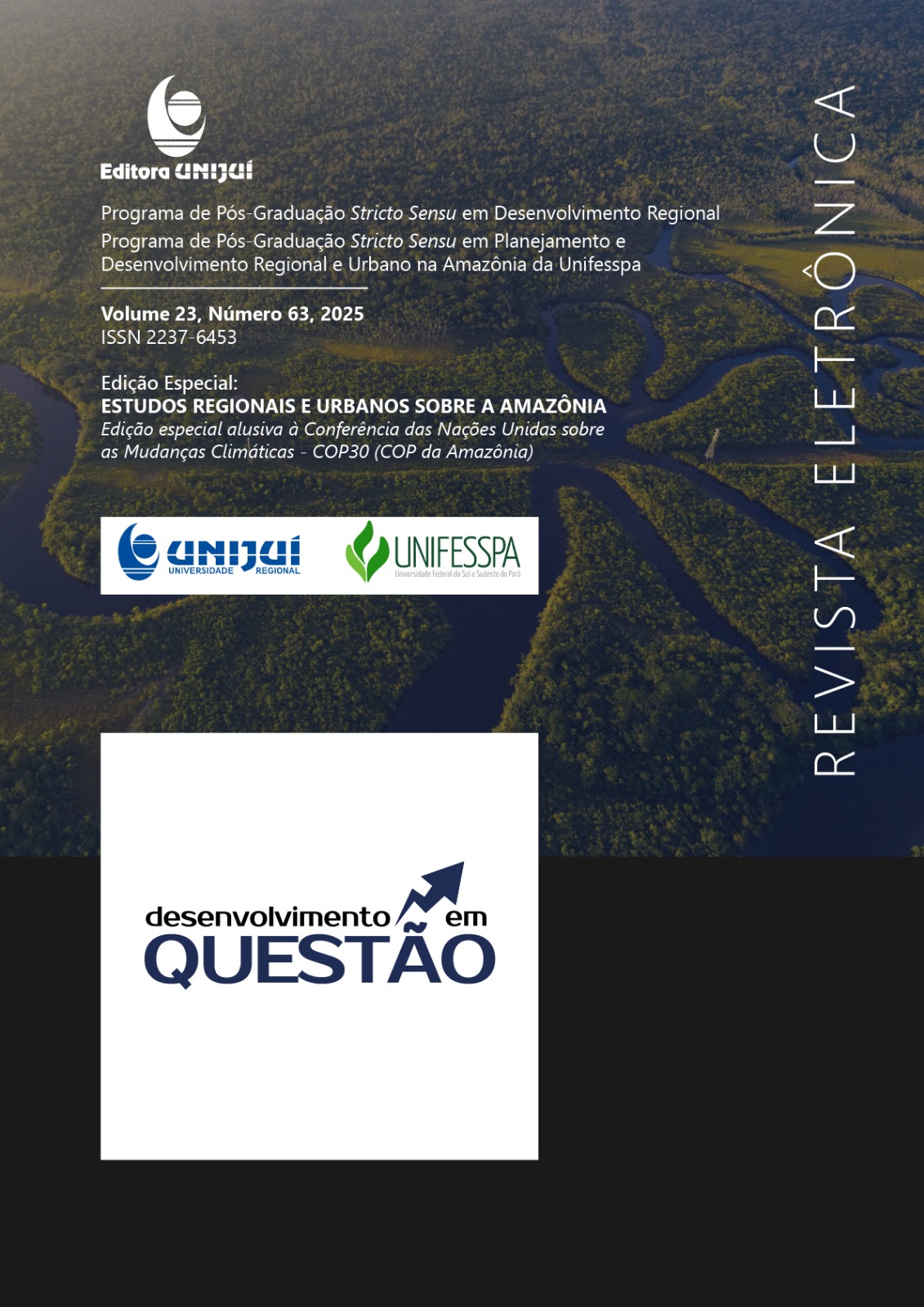Appropriation of public lands, chemical intensification of production and bioeconomic alternatives in the amazonian agrarian sector: the case of the Carajás region
DOI:
https://doi.org/10.21527/2237-6453.2025.63.17003Keywords:
Amazon, Carajás, agrarian economy, technological trajectoriesAbstract
This study characterizes the rapid changes in the agrarian economy structure of the Carajás region, highlighting how these transformations affect the relationships among economic agents, institutions, land use patterns, and the associated environmental impacts. The methodology, based on statistical analyses and data from the Agricultural Censuses of 1995/96, 2006, and 2017, made it possible to identify distinct productive trajectories, organized between large-scale and peasant segments, with emphasis on the predominance of cattle ranching, the emergence of grain crops, and the conversion of public lands into private areas for production. Among the results, the central role of the intensification of chemical input use — especially nitrogen fertilizers — stands out as a driving force for increasing land monetary productivity (PTR). However, this intensification is directly related to higher emissions of nitrous oxide (N₂O) — a greenhouse gas with a global warming potential hundreds of times greater than that of carbon dioxide (CO₂) — reinforcing the contribution of regional production to global warming. Finally, the expanded conclusions indicate that breaking with this pattern requires policies that limit the appropriation of public lands, promote the use of bio-inputs, and encourage technological alternatives based on Amazonian biodiversity, capable of diversifying and making agrarian production more sustainable.
References
ASSIS, W. S. A construção da representação dos trabalhadores rurais no sudeste paraense. 2007. Tese (Doutorado em Ciências Sociais em Desenvolvimento, Agricultura e Sociedade) – Universidade Federal Rural do Rio de Janeiro, Rio de Janeiro, 2007.
BAUMOL, W. J.; QUANDT, R. E. Rules of thumb and optimally imperfect decisions. The American Economic Review, v. 54, n. 2, p. 23-46, 1964. Disponível em: http://www.jstor.org/stable/1810896. Acesso em: 12 jul. 2025.
BOURSCHEIDT, V. et al. Inoculação de Azospirillum brasilense em gramíneas forrageiras para recuperação de pastagens degradadas. Pesquisa Agropecuária Tropical, Goiânia, v. 49, p. e54462, 2019. DOI: https://doi.org/10.1590/1983-40632019v4954462
BOYER, R. Formalizing growth regimes. In: DOSI, G.; FREEMAN, C.; NELSON, R.; SILVERBERG, G.; SOETE, L. (Org.). Technical change and economic theory. Londres: Pinter, 1988. p. 608-630.
BUSTAMANTE, M. M. C. et al. Estimating greenhouse gas emissions from tropical agriculture: current status, challenges and opportunities. Environmental Research Letters, v. 9, n. 11, p. 1–11, 2014. DOI: https://doi.org/10.1088/1748-9326/9/11/115003
CALIGARIS, L. S. et al. Bioinsumos na agricultura tropical: avanços, oportunidades e desafios para a produção sustentável. Revista Brasileira de Ciência do Solo, Viçosa, v. 47, e0230013, 2023. DOI: https://doi.org/10.36783/18069657rbcs20230013
CHEW, J. Y. et al. Bioinoculants for sustainable agriculture: current status and prospects. Agronomy, Basel, v. 13, n. 2, p. 1–24, 2023. DOI: https://doi.org/10.3390/agronomy13020436
CHULAN, A.; MARTIN, K. The vesicular-arbuscular (VA) mycorrhiza and its effects on the growth of vegetatively propagated Theobroma cacao L. Plant and Soil, v. 144, p. 227–233, 1992. DOI: https://doi.org/10.1007/BF00012879
COSTA, F. d. A. Mercado de terras e trajetórias tecnológicas na Amazônia. Economia e Sociedade, v. 21, p. 245-273, 2012. DOI: https://doi.org/10.1590/S0104-06182012000200002
COSTA, F. d. A. O investimento na economia camponesa: considerações teóricas. Revista de Economia Política, v. 15, n. 1, p. 84-101, 1995. DOI: https://doi.org/10.1590/0101-31571994-0766
COSTA, F. d. A. Structural diversity and change in rural Amazonia: a comparative assessment of the technological trajectories based on agricultural censuses (1995, 2006 and 2017). Nova Economia, v. 31, p. 415-453, 2021. DOI: https://doi.org/10.1590/0103-6351/6373
COSTA, F. d. A. Trajetórias tecnológicas como objeto de política de conhecimento para a Amazônia: uma metodologia de delineamento. Revista Brasileira de Inovação, v. 8, n. 1, p. 35-86, 2009. DOI: https://doi.org/10.20396/rbi.v8i1.8648975
CUENCA, G.; HERRERA, R.; MENESES, E. Effects of VA mycorrhiza on the growth of cacao seedlings under nursery conditions in Venezuela. Plant and Soil, v. 126, p. 71–78, 1990. DOI: https://doi.org/10.1007/BF00041370
DAVIDSON, E. A.; BUSTAMANTE, M. M. C.; PINTO, A. S. Emissions of nitrous oxide and nitric oxide from soils of native and exotic ecosystems of the Amazon and Cerrado regions of Brazil. The Scientific World Journal, v. 1, supl. 2, p. 312–319, 2001. DOI: https://doi.org/10.1100/tsw.2001.261
DOSI, G. Technological paradigms and technological trajectories: a suggested interpretation of the determinants and directions of technical change. Research Policy, v. 11, n. 3, p. 147-162, 1982. DOI: https://doi.org/10.1016/0048-7333(82)90016-6
EMMI, M. F. A oligarquia do Tocantins e o domínio dos castanhais. Belém: NAEA, 1999.
EMMI, M. F.; MARIN, R. E. A.; BENTES, R. d. S. Polígono Castanheiro do Tocantins: espaço contestado de oligarquias decadentes. Pará Agrário, n. 2, p. 12-21, 1987.
HALL, A. L. Amazônia: desenvolvimento para quem? Desmatamento e conflito social no Programa Grande Carajás. Rio de Janeiro: J. Zahar Editor, 1991.
HAYAMI, Y.; RUTTAN, V. W. Desenvolvimento agrícola: teoria e experiências internacionais. Rio de Janeiro: Embrapa, 1988.
HÉBETTE, J. et al. Cruzando uma zona de fronteira em conflitos: o leste do médio Tocantins. In: HÉBETTE, J. (Org.). Cruzando a fronteira: 30 anos de estudo do campesinato na Amazônia. Vol. 2. Belém: Edufpa, 2004. p. 51-128.
HUNGRIA, M. et al. Inoculation of Brachiaria spp. with the plant growth-promoting bacterium Azospirillum brasilense. Revista Brasileira de Zootecnia, Viçosa, v. 45, n. 12, p. 814–821, 2016. DOI: https://doi.org/10.1590/S1806-92902016001200003
IBGE – INSTITUTO BRASILEIRO DE GEOGRAFIA E ESTATÍSTICA. Censo Agropecuário 1995-1996 – Pará. Rio de Janeiro: IBGE, 1998.
IBGE – INSTITUTO BRASILEIRO DE GEOGRAFIA E ESTATÍSTICA. Censo Agropecuário 2006. Rio de Janeiro: IBGE, 2009.
IBGE – INSTITUTO BRASILEIRO DE GEOGRAFIA E ESTATÍSTICA. Censo Agropecuário 2017. Rio de Janeiro: IBGE, 2019.
IPCC – INTERGOVERNMENTAL PANEL ON CLIMATE CHANGE. Climate Change 2021: The Physical Science Basis. Contribution of Working Group I to the Sixth Assessment Report of the IPCC. Cambridge: Cambridge University Press, 2021. DOI: https://doi.org/10.1017/9781009157896
KAH, M.; KOOKANA, R. S.; GOGOS, A.; BUCHELI, T. D. A critical evaluation of nanopesticides and nanofertilizers against their conventional analogues. Nature Nanotechnology, v. 13, n. 8, p. 677–684, 2018. DOI: https://doi.org/10.1038/s41565-018-0131-1
KEYNES, J. M. Teoria geral do emprego, do juro e do dinheiro. 2. ed. São Paulo: Abril Cultural, 1982.
KWASHIE, G. K. S. et al. Synergic effect of arbuscular mycorrhizal fungi and potassium fertilizer improves biomass-related characteristics of cocoa seedlings to enhance their drought resilience and field survival. Open Agriculture, v. 8, n. 1, p. 20220239, 2023. DOI: https://doi.org/10.1515/opag-2022-0239
LAGE FILHO, N. M. et al. Land use, temperature, and nitrogen affect nitrous oxide emissions in Amazonian soils. Agronomy, v. 12, n. 7, p. 1608, 2022. DOI: https://doi.org/10.3390/agronomy12071608
MARTINS, J. S. Os camponeses e a política no Brasil: as lutas sociais no campo e seu lugar no processo político. Petrópolis: Vozes, 1995.
MICHELOTTI, F. Territórios de produção agromineral: relações de poder e novos impasses na luta pela terra no sudeste paraense. 2019. Tese (Doutorado em Planejamento Urbano e Regional) – Universidade Federal do Rio de Janeiro, Rio de Janeiro, 2019.
MICHELOTTI, F.; MIRANDA, H.; GOMES JÚNIOR, E. Ajuste espacial e temporal na Amazônia: reflexões sobre fronteira do capital e des-re-configurações territoriais. Novos Cadernos NAEA, v. 25, n. 4, p. 65-86, 2022. DOI: https://doi.org/10.18542/ncn.v25i4.13082
MIRBAKHSH, M. Role of nano-fertilizer in plants nutrient use efficiency (NUE): a mini-review. arXiv preprint arXiv:2301.09697, 2023. DOI: https://doi.org/10.48550/arXiv.2301.09697
MONTEIRO, M. A. Crescimento econômico e competitividade espúria na Amazônia: o caso da região de Carajás. Novos Cadernos NAEA, v. 25, n. 4, p. 333-363, 2022. DOI: https://doi.org/10.18542/ncn.v25i4.13035
MONTEIRO, M. A.; SILVA, A. Dados do agrário amazônico classificados por trajetória tecnológica: região de Carajás, 1996. Dataset – figshare, 2023a. Disponível em: https://doi.org/10.6084/m9.figshare.22298998.v1. Acesso em: 12 jul. 2025.
MONTEIRO, M. A.; SILVA, A. Dados do agrário amazônico classificados por trajetória tecnológica: região de Carajás, 2017. Dataset – figshare, 2023b. Disponível em: https://doi.org/10.6084/m9.figshare.22272193.v2. Acesso em: 12 jul. 2025.
MONTEIRO, M. A.; SILVA, R. P. Expansão geográfica, fronteira e regionalização: a região de Carajás. Confins [Online], n. 49, 16 mar. 2021. DOI: https://doi.org/10.4000/confins.35296
SAMANTARAY, A. et al. Advances in microbial based bio-inoculum for amelioration of soil health and sustainable crop production. Current Research in Microbial Sciences, v. 5, p. 100251, 2024. DOI: https://doi.org/10.1016/j.crmicr.2024.100251
SEEG – SISTEMA DE ESTIMATIVAS DE EMISSÕES E REMOÇÕES DE GASES DE EFEITO ESTUFA. Emissões de Gases de Efeito Estufa no Brasil (1970–2022). Observatório do Clima, 2024. Disponível em: https://seeg.eco.br/. Acesso em: 12 jul. 2025.
SIGNOR, D.; CERRI, C. E. P. Nitrous oxide emissions in agricultural soils: a review. Pesquisa Agropecuária Tropical, v. 43, p. 322–338, 2013.
SILVA, F. F. S. et al. Productive performance of Brachiaria brizantha cv. Paiaguás under different inoculation techniques of Azospirillum brasilense and nitrogen rates in the Brazilian Amazon. Agriculture, v. 6, n. 2, p. 47, 2023. DOI: https://doi.org/10.3390/agrisci6020047
SMITH, P. et al. Greenhouse gas mitigation in agriculture. Philosophical Transactions of the Royal Society B: Biological Sciences, v. 363, n. 1492, p. 789–813, 2012. DOI: https://doi.org/10.1098/rstb.2007.2184
SYAKILA, A.; KROEZE, C. The global nitrous oxide budget revisited. Greenhouse Gas Measurement and Management, v. 1, n. 1, p. 17–26, 2011. DOI: https://doi.org/10.3763/ghgmm.2010.000
Downloads
Published
How to Cite
Issue
Section
License
Copyright (c) 2025 Maurílio de Abreu Monteiro

This work is licensed under a Creative Commons Attribution 4.0 International License.
By publishing in Revista Desenvolvimento em Questão, authors agree to the following terms:
All works are published under the Creative Commons Attribution 4.0 International License (CC BY 4.0), which allows:
Sharing — to copy and redistribute the material in any medium or format;
Adaptation — to remix, transform, and build upon the material for any purpose, even commercially.
These permissions are irrevocable, provided that the following terms are respected:
Attribution — authors must be properly credited, a link to the license must be provided, and any changes made must be indicated.
No additional restrictions — no legal or technological measures may be applied that legally restrict others from doing anything the license permits.
Notices:
The license does not apply to elements that are in the public domain or covered by legal exceptions.
The license does not grant all necessary rights for specific uses (e.g., image rights, privacy, or moral rights).
The journal is not responsible for the opinions expressed in the articles, which are the sole responsibility of the authors. The Editor, with the support of the Editorial Board, reserves the right to suggest or request modifications when necessary.
Only original scientific articles presenting research results of interest that have not been previously published or simultaneously submitted to another journal with the same purpose will be accepted.
Mentions of trademarks or specific products are intended solely for identification purposes and do not imply any promotional relationship by the authors or the journal.
License Agreement (for articles published from 2025 onward): Authors retain the copyright to their article and grant Revista Desenvolvimento em Questão the right of first publication.











